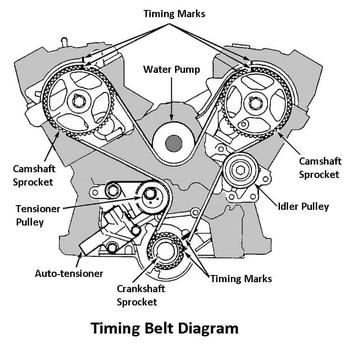A timing belt is a crucial component in an internal combustion engine, playing a vital role in synchronizing the movement of the crankshaft and camshaft. This synchronization ensures that the engine valves open and close at the right time during each cylinder’s intake and exhaust strokes. Understanding the timing belt’s definition, its functions, and its purpose can help you appreciate its importance in vehicle maintenance.
What is a Timing Belt? Definition and Meaning
The timing belt is a toothed rubber belt designed to transfer rotational energy efficiently between the engine’s crankshaft and camshaft. Its primary function is to ensure that the engine’s valves and pistons operate in harmony, preventing collisions that could lead to engine failure.
Function and Purpose of a Timing Belt
The function of a timing belt goes beyond just synchronizing engine parts. It also helps:
- Maintain smooth engine performance.
- Optimize fuel efficiency.
- Reduce wear and tear on the engine.
The purpose of a timing belt is to keep the engine running efficiently while minimizing mechanical stress. A well-maintained timing belt directly impacts the vehicle’s overall performance.
Timing Belt Diagram: An Easy Explanation
Below is a detailed diagram of a timing belt, showcasing its connection to the crankshaft, camshaft, and other essential engine components.

This timing belt diagram visually explains how the belt transmits power and keeps engine components in sync.
Working of a Timing Belt
- The crankshaft rotates, transferring motion to the timing belt.
- The timing belt moves the camshaft, which controls the opening and closing of the engine valves.
- This process ensures that the valves and pistons do not collide, enabling smooth combustion cycles.
Importance of Regular Timing Belt Maintenance
Failure to maintain the timing belt can lead to severe engine damage. Regular inspections ensure that the belt is in good condition, free of cracks, and correctly tensioned.
Frequently Asked Questions (FAQs)
1. What is the function of a timing belt?
The primary function of a timing belt is to synchronize the movement of the crankshaft and camshaft, ensuring proper engine operation.
2. What happens if a timing belt breaks?
A broken timing belt can cause severe engine damage, including bent valves, cylinder head damage, and even total engine failure.
3. What is shown in a timing belt diagram?
A timing belt diagram illustrates the belt’s positioning and its connection to the engine’s crankshaft and camshaft.
4. What is the purpose of a timing belt in an engine?
The purpose of a timing belt is to maintain precise timing between the engine valves and pistons, preventing mechanical failures.
Conclusion
The timing belt is a small yet essential part of an engine’s operation. By understanding its definition, functions, and purpose, and regularly inspecting it for wear, you can prevent costly repairs and ensure a long life for your engine. Use the provided timing belt diagram to familiarize yourself with its working, and consult a professional mechanic for maintenance advice.



